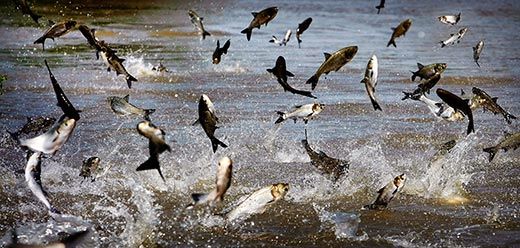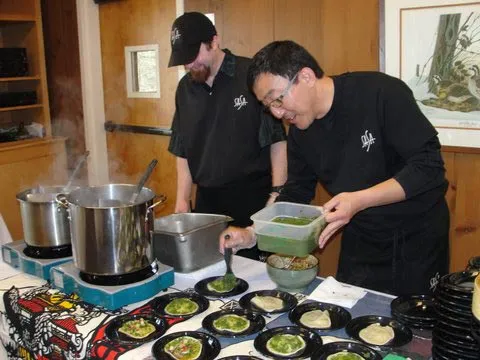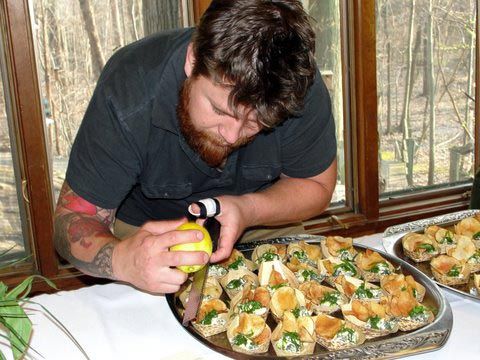Making the Best of Invasive Species
Garlic mustard and Asian carp can wreak havoc on their ecosystems, but do they have a future on your dinner plate?
/https://tf-cmsv2-smithsonianmag-media.s3.amazonaws.com/filer/Pestival-Asian-carp-631.jpg)
The lowly garlic mustard had never seen so much love.
This prolific invasive plant—cursed by home gardeners and park and wildlife managers alike—is routinely wrenched from the ground or spritzed with herbicide in an attempt to keep it from taking over. But on April 14 at Cleveland’s Shaker Lakes Nature Center, garlic mustard was the guest—or rather, pest—of honor.
“Pestival 2011” featured seven of Cleveland’s most notable chefs making garlic mustard a gourmet treat. They rose to the occasion deliciously: garlic mustard sauce over thin slices of roast beef, garlic mustard pesto on pork tenderloin crostinis, garlic mustard chutney on wonton-skin ravioli stuffed with tofu and paneer cheese, garlic mustard dip for thick-cut potato chips, and garlic mustard relish on chèvre cheesecake. The 125 attendees clustered around the chefs’ silvery platters, then carried artfully arranged portions of the garlic-mustard creations back to white-linen draped tables.
Would all this culinary artfulness persuade people to cook up some garlic mustard on their own, or at least recognize it when they see it along a path in a public park and yank it out?
“We hope so!” says Terri Johnson, the nature center’s special events manager. “We look forward to the day when garlic mustard is eradicated. Then we’ll hold Pestival as a victory celebration.”
Garlic mustard is just one of 50,000 alien plant and animal species that have arrived in the United States. These invaders flourish in the absence of their native competitors and predators. European settlers brought garlic mustard here for their kitchen gardens. An attractive plant with heart-shaped leaves and tiny white flowers, it outcompetes native plants for light, moisture, nutrients, soil and space. It propagates at a fierce speed, producing thousands of seeds that spread by sticking to animals’ fur.
“If you don’t control it, woods filled with native species can be completely taken over by garlic mustard in five years,” says Sarah Cech, the nature center’s naturalist.
When the nature center first conceived Pestival six years ago—the first one was a simpler event in which the staff prepared a garlic-mustard pesto served with spaghetti for 80 guests—they didn’t realize they were part of a national trend. The United States spends around $120 billion each year to control invasive species, according to Cornell University ecologist David Pimentel. But in the past decade or so, a growing number of people have decided to view the crisis of surging alien populations as an opportunity to expand the American palate. If these species are out of control because they have no natural predators, then why not convince the fiercest predator of all—human beings—to eat them? The motto of these so-called invasivores is, “If you can’t beat ’em, eat ’em.”
Take the Asian carp (please!). Imported from China in 1973 to clean algae from Southern ponds, the carp soon broke from their confines and infested Mississippi River waterways. Gobbling up the phytoplankton that support native species, the carp can grow four feet long and weigh 100 pounds. They continue to swim north and could establish themselves in the Great Lakes, the world’s largest freshwater system, and decimate native fish populations there.
Wildlife managers have tried to prevent Asian carp and other invasive species from reaching the Great Lakes by installing electric underwater fences and, occasionally, poisoning the water. But chefs from New Orleans to Chicago have also tried to put a dent in the population by putting the fish on their menu. Now, a researcher at the Aquaculture Research Center at Kentucky State University is trying to figure out how to harvest and promote carp as a food source. Currently, a few processing plants are converting Asian carp into ingredients for fertilizer or pet food. “That’s a shame, because the meat quality is excellent,” says Siddhartha Disgupta, an associate professor at the center.
Disgupta argues that the carp has all the health benefits associated with eating fish and, since it eats low on the food chain, has few contaminants such as mercury that tend to be concentrated in the flesh of other fish species. He says he’s eaten Asian carp in various preparations and found it delicious. But even though this species of carp is prized as a tasty fish in China, Americans usually grimace at the idea of eating it.
“There’s a negative prejudice to the name,” Disgupta says. “People think they’re bottom feeders. They get them mixed up with suckers, which look similar but are from a different biological family.”
In Florida, George Cera has trained his fork on a different invasive creature: the spiny-tailed black iguana, which was imported as an exotic pet, then escaped and proliferated. Cera was hired by the town of Boca Grande on Gasparilla Island to hunt and kill the iguanas, which feast on endangered plants as well as the eggs of protected sea turtles, gopher tortoises and burrowing owls. “They grab and eat them like we’d eat a cherry tomato,” Cera says.
In two years, Cera bagged 12,000 iguanas, his conscience soothed as he found parts of protected species inside them. But it bothered him to kill an animal without eating it. Then, he met some Central and South American tourists who told him that iguanas are considered a delicacy back home, where they’re a native species. They gave Cera recipes. He tracked down more on his own and produced an iguana cookbook.
“I thought it would be a fun way to educate the public,” Cera says. “Now, people come and ask me where they can get some of this meat.”
Perhaps no one tackles the issue of eating invasives with as much gusto as Jackson Landers, author of The Locavore Hunter blog. Over the past year, he’s traveled the country hunting invasives and gathering material for his new book, Eating Aliens. Landers has hunted and eaten feral pigs in Georgia, green iguanas in the Florida Keys, pigeons in New York City, Canada geese in Virginia and European green crabs in Massachusetts, among others.
“As a systematic approach to invasives, eating them should be a major component,” Landers says. “After all, human beings have eaten other species to extinction.”
Not everyone agrees with this approach, however. Sarah Simons, executive director of the Global Invasive Species Programme, echoes the thoughts of some wildlife managers, saying, “There is currently no evidence whatsoever to demonstrate a reduction in population size, or effective management, of invasive species by consuming them. More often, it is quite the reverse which occurs—promoting the consumption of an invasive species can actually create a market, which in turn increases the spread or introduction of invasive species.”
The organizers of Cleveland’s Pestival are well aware of the fine and dangerous line between educating people about garlic mustard—including its edibility—and inadvertently inspiring them to cultivate it in their backyards. But there seemed to be little cause for worry at the event. Most of the preparations offered an array of flavors, and it was hard for the diners to isolate the particular taste of garlic mustard. Some of the chefs only shrugged when asked if they planned to make the wayward green a regular part of their menu.
The exception was Jonathon Sawyer, owner of the Greenhouse Tavern and named a Best New Chef of 2010 by Food and Wine magazine. Sawyer loves to forage the ring of parks around Cleveland and has been carrying garlic mustard back to use in his restaurant and home for five years. In the springtime, he likes to eat the leaves raw, comparing their taste and bite to arugula. As the plants get older, he blanches and eats them like mustard greens.
“Dude, it’s the ultimate food!” Sawyer exclaimed as he passed out his artichoke and spinach dip with crème fraiche, garlic mustard and thick-cut potato chips. “It’s free, and nature wants us to get rid of it.”




